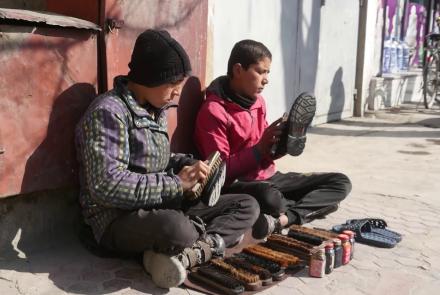As Afghanistan goes through a severe humanitarian and economic crisis, thousands of children have recently engaged in hazardous work seeking to make money and feed their families.
Many of them are working as shoe polishers and vendors on the street while others are engaged working in car shops and bakeries.
Earlier, Save the Children in a report said up to one fifth of families in Afghanistan have been forced to send their children out to work as incomes have plummeted in the past six months with an estimated one million children now engaged in child labor.
“According to Save the Children’s analysis, if just one child in each of these families is being sent to work, then more than one million children in the country are engaged in child labor,” Save the Children said in a recent report.
The long decades of conflict have left hundreds of thousands of widows and orphans who are struggling with poverty. The war has impacted the Afghan nation in an indirect manner as well--as many have become addicted to drugs due to the Afghan government’s inability to control drug trafficking in the country.
Naseer Ahmad, 11, works as a shoe polisher everyday alongside his younger brother on a street in the capital city of Kabul.
“I was hit by a car a year ago. My feet don’t work properly. I should have my feet fixed, but we still owe some money to the drugstores,” he said.
Naseer’s mother said that her husband is drug addict, thus the children are obliged to engage in laboring to take care of the family.
“Both of them are working as shoe polishers. They earn money some days but not every day. (They) don’t earn more than 50-60 Afs. We are paying 3,500 Afs for house rent,” said Naseer’s mother.
Naseer is one the thousands of children who are spending their days on the Kabul streets to earn money.
“I am the breadwinner of the family. My father is jobless. We live in a rented house. There is no one in our family to work so I have to do so,” said Tofan, a child laborer.
“I work from dawn till dusk and therefore I can’t go to school,” said a child laborer.
“To move the Afghan economic cycle, there is a need to create job opportunities to counter the permanent problems of poverty in the country” said Iraj Faqiri, an economist.
According to a recent report of the United Nations Children's Fund (UNICEF), more than 1 million children will need treatment for severe acute malnutrition.
“Nearly 13 million children will need humanitarian assistance. Diseases like measles and acute watery diarrhea will continue to spread,” the report read. “Up to 97 per cent of all Afghan families could be living below the poverty line in a matter of months.”


Comment this post